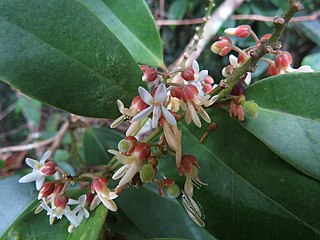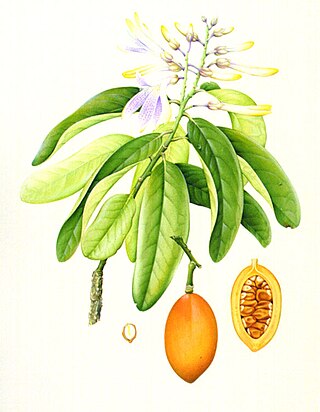
Pleiogynium timoriense, commonly known as the Burdekin plum, sweet plum, tulip plum, or in the Djabugay language guybalum, is a medium-sized fruit-bearing tree in the cashew and mango family Anacardiaceae native to Malesia, Australia and the Pacific Islands.

Normanbya is a monotypic genus of palms containing the single species Normanbya normanbyi, which is known by the common name black palm It is endemic to Queensland, Australia and is threatened by habitat destruction.

Alpinia caerulea, commonly known as native ginger or Australian ginger, is an understorey perennial herb in the family Zingiberaceae which grows in rainforest, gallery forest and wet sclerophyll forest in eastern Australia.

Semecarpus australiensis, commonly known as the tar tree, native cashew, marking nut, or cedar plum, is a species of tree in the cashew, sumac and mango family Anacardiaceae, native to parts of Melanesia and northern Australia. Contact with the plant can cause serious allergic reactions, a common characteristic of this family.

Atractocarpus fitzalanii, commonly known as the brown gardenia or yellow mangosteen, is a species of plant in the coffee and madder family Rubiaceae. It is found in coastal parts of tropical Queensland, Australia. The beautifully scented flowers and glossy foliage has seen this plant enter cultivation in gardens of eastern Australia.

Phaleria clerodendron, commonly known as scented daphne, scented phaleria or rosy apple, is an evergreen tree or tall shrub in the family Thymelaeaceae. It is endemic to the rainforests of north-eastern Queensland, Australia.

Didymocheton pettigrewianus, commonly known as spur mahogany, spurwood, or Cairns satinwood, is a large tree in the family Meliaceae. It is native to the rainforests of Malesia, Papuasia and Queensland. In Queensland it occurs only in a small part of the northeast coast.

Syzygium forte, commonly known as flaky-barked satinash, white apple or brown satinash, is a tree in the family Myrtaceae native to New Guinea and northern Australia.

Palaquium galactoxylum, commonly known as Cairns pencil cedar, Daintree maple or red silkwood, is a species of plants in the star apple family Sapotaceae which is endemic to rainforests of New Guinea and northern Australia. It can produce spectacularly large buttress roots.

Gardenia actinocarpa is a rare and endangered plant in the coffee and gardenia family Rubiaceae, native to a very restricted area within the Wet Tropics rainforest of northeastern Queensland.

Hypserpa laurina is a slender twining climber in the plant family Menispermaceae. It is native to New Guinea and northeastern Queensland in Australia.

Diploglottis harpullioides, commonly known as Babinda tamarind, is a rainforest tree in the lychee and maple family Sapindaceae which is found only in northeast Queensland, Australia.

Xanthophyllum octandrum, commonly known as Macintyre's boxwood, false jitta, yellow boxwood or sovereignwood, is a slow-growing tree in the milkwort family Polygalaceae which has the potential to reach thousands of years of age. It is endemic to coastal northeastern Queensland, Australia.

Alpinia arctiflora, commonly known as the pleated ginger, is a plant in the ginger family Zingiberaceae which is endemic to northeastern Queensland.

Cleistanthus apodus, commonly known as the weeping Cleistanthus, is a tree in the family Phyllanthaceae native to New Guinea and northeast Queensland. It was first described in 1873 by the English botanist George Bentham in his seven-volume book Flora Australiensis.

Sterculia shillinglawii, commonly known as tulip sterculia or lacewood, is a tree in the cotton and cocoa family Malvaceae, native to Papuasia and northeastern Australia.

Actephila foetida is a plant in the family Phyllanthaceae that is found only in a very restricted range within the Wet Tropics bioregion of Queensland, Australia. It was first described in 1927.

Xanthophyllum fragrans, commonly known as fragrant boxwood, is an evergreen plant in the family Polygalaceae found only in the Wet Tropics bioregion of Queensland, Australia.

Astrotricha pterocarpa is a plant in the ivy family Araliaceae found only in tropical Queensland, Australia.

Rhodamnia sessiliflora, commonly known as iron malletwood, is a small tree in the eucalyptus family Myrtaceae, found only in the Wet Tropics bioregion of Queensland, Australia.


























